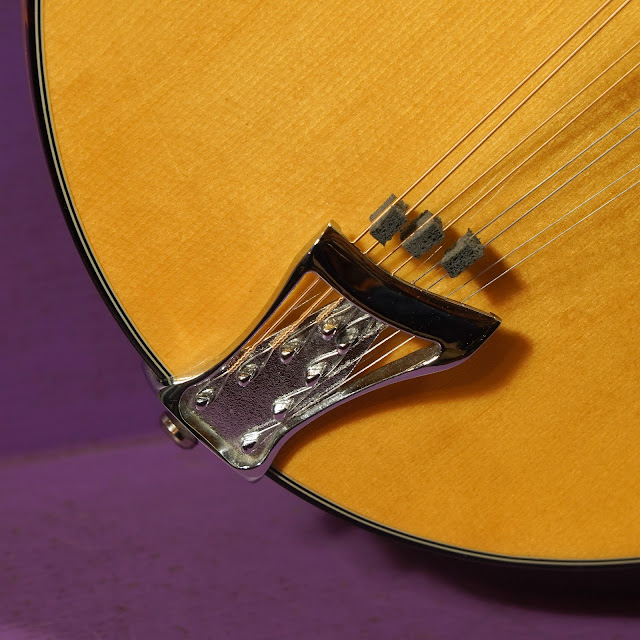2000s Paris Swing Nuages MS-120-N F-Style Mandolin
Update November 2022: I sold this instrument and fit a K&K pickup at the time. After a month or so the top continued to sink on it enough that the setup couldn't be kept-up well enough to keep it playing. I took it back in trade and then it sat until early November on my workbench. I finally decided to add some bracing to reinforce the top and then also converted it into a 4-string instrument. It's now finally stable and happy. I made a fresh blog post which you can find here that talks all about this. Now back to the original post...
I'm not sure if this is the Korean-made version or the Chinese-made version of this instrument -- I'm leaning towards late-production Korean with a pressed (not carved) top, though it sounds carved, so I might be entirely wrong. In any case, it's a screamer and both plays and looks great. I remember seeing these when they came out and thinking they were pretty dang cool at the time. I really liked the look of the snazzy D-hole models but this oval-hole variant is slick as well.
It's solid spruce over solid flamed maple and has a flamed maple neck and ebony board. The bridge is stained rosewood, though, in an odd twist. It has nice tortoise binding on all the edges and the elongated scroll and gypsy-style flat cutaway on the treble side give it a classy appearance. It has a nice, straight, Gibson-esque neck, very-raised fretboard extension, way too many frets, good tuners, and a cool headstock veneer with the Eiffel tower.
Construction-wise, though, all that horsepower (these are stupid-loud and punchy) comes at acost. The top has only a single tonebar-style brace right down the middle. As a result, when combined with that big soundhole, the top has compressed/collapsed a under tension. It's still arched in profile but when you apply tension you can watch the string height go down and need to crank the bridge top up a bunch to compensate. This construction flaw is the same as on the old '20s and '30s Shutt-style mandolins which were carved and unbraced. On those you definitely need the adjustable bridge so you can dial-in your action after tension is applied, too. I don't think that, long term, this is more of an issue than on the old Shutts, as once they've settled and you've adjusted for it, they more or less stay put.
I will say that I'm very tempted to make a wide, gypsy-looking ebony base for the bridge (update: I later did, but it didn't help with the sinking), though, with a little more height and "points" that would terminate about 1" from either side of the top. I think that would help with this flaw and also look great.
All that said, yes -- it's a player's mandolin for sure -- loud and up-front with lots of cut and a mellow burr to its voice which is not quite bluegrassy and definitely not folky, though it does the Celtic thing alright, too.
Repairs included: added longer posts for bridge, restring, setup.
Top wood: solid spruce
Back & sides wood: solid flamed maple
Bracing type: single tonebar
Bridge: rosewood, stained
Fretboard: ebony
Neck wood: flamed maple
Action height at 12th fret: hair under 1/16" overall (fast!)
String gauges: 36w-10
Neck shape: medium V
Board radius: flat
Truss rod: adjustable
Neck relief: straight
Fret style: smaller
Scale length: 13 3/4"
Nut width: 1 1/8"
Body width: 10 1/8"
Body depth: 1 5/8" + arching
Weight: 2 lbs 3 oz
Condition notes: it's pretty clean throughout and only shows the mildest usewear/playwear via light scratching here and there. As per the usual on this line of mandolins, the top sinks under tension so it needs a taller bridge to compensate for it. I didn't need to do a level/dress of the frets because they are essentially unplayed and the factory set them nicely. There's one little "kink" in the binding at the soundhole and that looks like it left the factory that way. You can see it near the end of the fretboard extension on the bass side.




















Comments